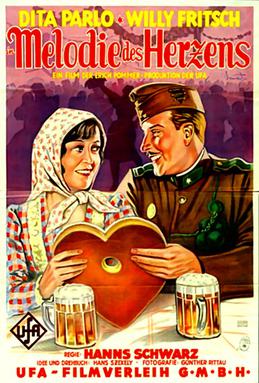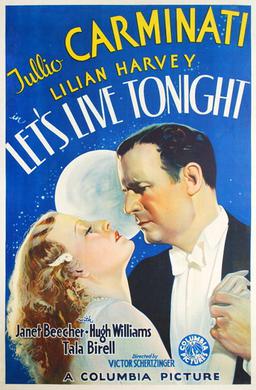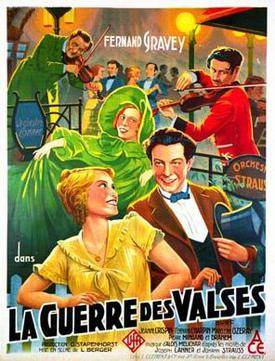Happy Ever After is a 1932 British-German musical film directed by Paul Martin and Robert Stevenson, and starring Lilian Harvey, Jack Hulbert, Cicely Courtneidge, Sonnie Hale, and Edward Chapman.

Monte Carlo Madness is a 1932 German musical comedy film directed by Hanns Schwarz and starring Sari Maritza, Hans Albers and Charles Redgie. It was an English-language version of the 1931 German film Bombs on Monte Carlo, which was based on the 1930 novel Bombs on Monte Carlo by Fritz Reck-Malleczewen. The screenplay concerns a captain who falls in love with a Queen in Monte Carlo. It cost 375,000 ℛ︁ℳ︁ to produce.
Günther Krampf was an Austrian cinematographer who later settled and worked in the UK. Krampf has been described as a "phantom of film history" because of his largely forgotten role working on a number of important films during the silent and early sound era. Only two of Krampf's films The Student of Prague (1926) and The Ghoul (1933) were expressionist, as he generally used a naturalistic style.
Number 17 is a 1928 German-British silent and sound crime film directed by Géza von Bolváry and starring Guy Newall, Lien Deyers, and Carl de Vogt. The English version was produced with sound. While the sound version has no audible dialog, it features a synchronized musical score with sound effects.
Felsom Film was a film production company which operated in Weimar Germany between 1922 and 1933. It was founded and run by producers Hermann Fellner and Josef Somlo. The company's name is a blend of their surnames.

Melody of the Heart is a 1929 German musical film directed by Hanns Schwarz and starring Dita Parlo, Willy Fritsch and Gerő Mály.
Whitechapel is a 1920 German silent crime film directed by Ewald André Dupont and starring Guido Herzfeld, Hans Mierendorff, and Otto Gebühr. The film was set around a variety theatre in London's East End suburb of Whitechapel.

The White Peacock is a 1920 German silent drama film directed by Ewald André Dupont and starring Guido Herzfeld, Hans Mierendorff and Karl Platen. It was shot at the Tempelhof Studios in Berlin. The film's sets were designed by the art directors Paul Leni, Robert A. Dietrich and Otto Moldenhauer

The Marathon Runner is a 1933 German sports film directed by Ewald André Dupont and starring Brigitte Helm, Hans Brausewetter and Ursula Grabley. It was based on a 1928 novel by Werner Scheff, adapted by screenwriter Thea von Harbou. The film focuses on a love triangle between three German athletes competing at the 1932 Olympic Games in Los Angeles. It was shot at the Johannisthal Studios in Berlin with sets designed by the art directors Ernő Metzner and Erich Zander. The German premiere took place at the Ufa-Palast am Zoo. It was the last film Dupont made in Germany, before escaping into exile following the rise to power of the Nazis.

Let's Live Tonight is a 1935 American musical comedy film directed by Victor Schertzinger and starring Lilian Harvey, Tullio Carminati and Janet Beecher. The film was made as part of an unsuccessful attempt to establish Harvey, who was a top box office draw in Germany, as a major star in Hollywood. Harvey was under contract to Fox Film, but was loaned out to Columbia Pictures for the production. After making it, Harvey returned to Europe, first to Britain to appear in Invitation to the Waltz and then to Germany, where she starred in Black Roses, which relaunched her German career.

Waltz of Love is a 1930 German musical film directed by Wilhelm Thiele and starring Lilian Harvey, Willy Fritsch and Georg Alexander. It was shot at the Babelsberg Studios in Berlin with sets designed by the art director Erich Kettelhut. It premiered at the Gloria-Palast in Berlin on 7 February 1930. A separate English language version The Love Waltz was also produced.
The Love Waltz is a 1930 German English language musical film directed by Carl Winston and starring Lilian Harvey, Georg Alexander and John Batten. It is the English-language version of Waltz of Love (1930) which also starred Harvey.
Walter Murton was a British art director, who worked from the 1920s until the 1940s. During his early career in the 1920s Murton was the regular set designer on the silent film series The Further Adventures of Sherlock Holmes and The Mystery of Dr. Fu Manchu.
Staaken Studios was a film studio located in Staaken on the outskirts of the German capital Berlin. A large former zeppelin hangar, it was converted to film use following the First World War and operated during the Weimar Republic. In July 1923 it was the largest studio in the world, with floor space of around 18,000 square feet. It was used for the construction of massive sets on a series of major productions of the silent era, including I.N.R.I., Metropolis, The Holy Mountain and The Ship of Lost Souls. These epics were a part of the German attempt on world markets during the decade. The 1927 Anglo-German co-production The Ghost Train was shot at Staaken.

Court Waltzes is a 1933 musical film directed by Ludwig Berger and Raoul Ploquin and starring Fernand Gravey, Armand Dranem and Madeleine Ozeray. It was the French-language version of Waltz War, made by the German studio UFA and also directed by Berger. In the early years of sound it was common to shoot completely separate versions of films in different languages before dubbing became more established. It was part of a trend of operetta films released during the decade.

Ronny is a 1931 musical comedy film directed by Roger Le Bon and Reinhold Schünzel and starring Käthe von Nagy, Marc Dantzer and Fernand Frey. It was made by UFA as the French-language version of Ronny. Such multiple-language versions were common in the early years of sound.

The Only Girl is a 1933 British-German musical film directed by Friedrich Hollaender and starring Lilian Harvey, Charles Boyer, and Mady Christians. It is the English-language version of The Empress and I which also starred Harvey and Christians. It was the last in a series of MLV co-productions between UFA and Gainsborough Pictures. It was released in the United States in 1934 by Fox Film.

The Tempelhof Studios are a film studio located in Tempelhof in the German capital of Berlin. They were founded in 1912, during the silent era, by German film pioneer Alfred Duskes, who built a glass-roofed studio on the site with financial backing from the French company Pathé. The producer Paul Davidson's PAGU then took control and constructed a grander structure. The First World War propaganda drama The Yellow Passport, the historical comedy Madame DuBarry and the expressionist 1920 silent film The Golem were made there by PAGU.
Tell Me Tonight or Be Mine Tonight is a 1932 British musical comedy film directed by Anatole Litvak and starring Jan Kiepura, Sonnie Hale and Magda Schneider. It was shot in Berlin at the Babelsberg Studios as part of a co-production between Gainsborough Pictures and the German firm Cine-Allianz. A separate German-language version The Song of Night was also released.

Salto Mortale is a 1931 German drama film directed by Ewald André Dupont and starring Anna Sten, Anton Walbrook and Reinhold Bernt. A circus film, it has been described as being "in all but name a sound film remake of Variety" and was a box office success.










